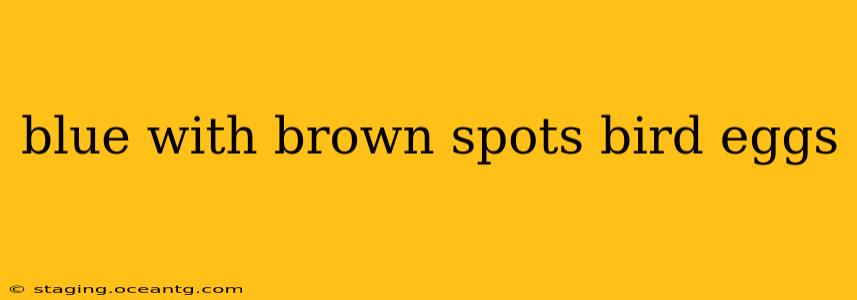Many bird species lay eggs that are a beautiful blue speckled with brown spots. This striking coloration isn't just aesthetically pleasing; it serves a vital purpose in protecting the developing chicks. This guide will delve into the world of blue eggs with brown spots, exploring the species that lay them, the reasons behind the unique coloration, and frequently asked questions surrounding these fascinating avian treasures.
What Birds Lay Blue Eggs with Brown Spots?
Several bird species lay eggs exhibiting this distinctive blue-and-brown pattern. Pinpointing the exact species requires considering other factors like egg size, shape, and nesting location. However, some common culprits include:
- Robin (various species): American Robins, European Robins, and other robin species are known for laying eggs that range from a pale blue to a deeper blue, often with reddish-brown speckles. The intensity of the color and spotting can vary significantly.
- Thrushes: Many thrush species, including the Song Thrush and Mistle Thrush, produce eggs with similar characteristics—a blue base with varying degrees of brown spotting.
- Wrens: Certain wren species also lay eggs that are a pale blue with brown spots, though the intensity of the color and the density of spots can differ.
It's crucial to remember that egg color and markings can be highly variable even within the same species. Factors such as diet, genetics, and individual bird health can influence the final appearance of the egg.
Why Do Some Bird Eggs Have Blue and Brown Spots?
The coloration of bird eggs is a fascinating subject, often serving as camouflage. The blue base, combined with brown spots, helps to:
- Camouflage: The speckled pattern breaks up the outline of the eggs, making them harder for predators to spot against the background of nests often situated in leafy environments. The blue color can blend with shadows and foliage.
- Thermoregulation (possibly): While camouflage is the primary theory, some researchers suggest a possible role in thermoregulation, although this is less extensively studied. The color might impact how the eggs absorb and retain heat.
How Can I Identify a Bird Based on Its Eggs?
Identifying a bird solely based on its egg color and markings can be challenging and often inconclusive. Egg characteristics alone are rarely definitive. To accurately identify the bird, you need to consider several other factors:
- Nest location and structure: Where is the nest located? What materials are used to build it?
- Egg size and shape: Measure the egg's dimensions and observe its shape (oval, round, pointed, etc.).
- Number of eggs in the clutch: How many eggs are there in the nest?
- Geographic location: Where was the nest found? This narrows down the possibilities considerably.
- Observations of the adult bird: If possible, observing the adult bird's behavior, size, and plumage is the most reliable identification method.
What Does the Color of a Bird's Egg Tell Us?
While the blue and brown spotting primarily serves as camouflage, the overall color of bird eggs can provide additional clues. The color pigments in the eggshell are produced by the bird's body and are influenced by several factors, including its diet. Further research is ongoing to fully understand the relationship between egg color and bird health or environmental factors.
Are Blue Eggs with Brown Spots Rare?
No, blue eggs with brown spots are not uncommon, especially among certain bird families. While not every bird lays eggs like this, it's a fairly prevalent pattern in many common bird species. However, the specific shade of blue and the density of the brown spots can vary widely, adding to the beauty and diversity of avian eggs.
This comprehensive guide offers a detailed exploration of blue bird eggs with brown spots. Remember, observing birds and their nests requires responsible behavior. Always maintain a safe distance, avoid disturbing the nest or parent birds, and prioritize the well-being of the wildlife.
